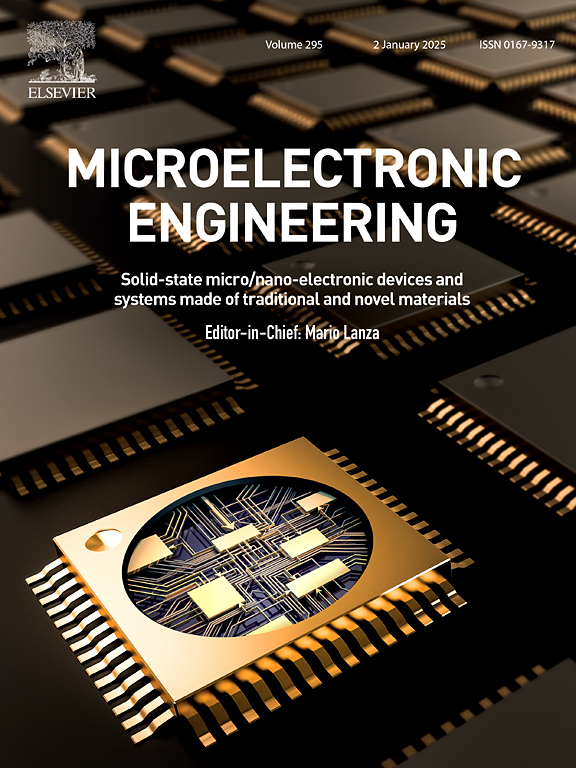Advanced gallium nitride high electron mobility transistors for biosensing applications: Progress, challenges, and future perspectives
IF 3.1
4区 工程技术
Q2 ENGINEERING, ELECTRICAL & ELECTRONIC
引用次数: 0
Abstract
GaN High Electron Mobility Transistors represent a breakthrough technology for biosensing applications, offering exceptional sensitivity through their unique two-dimensional electron gas channel positioned close to the sensing surface. This comprehensive review provides the first systematic analysis of the complete GaN HEMT biosensor ecosystem, distinguishing itself from previous reviews through: (i) Comprehensive coverage of emerging architectural innovations including novel heterostructures, dimensional variants, and advanced gate engineering approaches; (ii) Detailed analysis of MOS-HEMT configurations and their superior performance in physiological media; and (iii) Critical assessment of commercialization challenges and practical implementation strategies. The fundamental advantage of GaN HEMTs lies in their ability to detect minute charge variations from biomolecular interactions with detection limits reaching attomolar concentrations, enabled by the 2DEG channel's proximity (20–30 nm) to the sensing surface. The review systematically examines device architectures ranging from conventional AlGaN/GaN structures to advanced MOS-HEMT designs with dielectric layers that provide 2–3× sensitivity enhancement while improving stability in high ionic strength media. Novel heterostructures including InAlN/GaN systems and N-polar configurations offer up to 4× sensitivity improvements compared to conventional designs. Different gate engineering approaches are analyzed, encompassing dual-gate architectures for differential sensing, recessed designs for enhanced control, and extended-gate configurations for harsh environments.
This review uniquely addresses the critical interface between device physics and practical biosensing through comprehensive analysis of surface functionalization strategies, charge screening mitigation techniques, and biocompatibility considerations. Current limitations including signal drift (0.1–2.0 mV/h), selectivity challenges in complex biological matrices, and manufacturing reproducibility (5–15 % coefficient of variation) are critically evaluated alongside emerging solutions involving differential measurements, anti-fouling surface modifications, and machine learning algorithms. Future developments focus on transformative trends not comprehensively covered in previous reviews: self-powered sensors with integrated energy harvesting, multi-modal detection platforms combining optical and electrochemical sensing, IoT-connected monitoring networks for population-level healthcare, and expanding environmental monitoring applications. These advances position GaN HEMT biosensors as enabling technologies for next-generation healthcare diagnostics, environmental monitoring, and smart sensing ecosystems.
用于生物传感应用的先进氮化镓高电子迁移率晶体管:进展、挑战和未来展望
氮化镓高电子迁移率晶体管代表了生物传感应用的突破性技术,通过其独特的二维电子气通道靠近传感表面提供卓越的灵敏度。这篇综合综述首次对完整的GaN HEMT生物传感器生态系统进行了系统分析,与之前的综述不同之处在于:(i)全面覆盖了新兴的建筑创新,包括新型异质结构、尺寸变体和先进的门工程方法;(ii)详细分析MOS-HEMT结构及其在生理介质中的优越性能;(三)对商业化挑战和实际执行战略进行批判性评估。GaN hemt的基本优势在于它们能够检测生物分子相互作用产生的微小电荷变化,检测限达到原子摩尔浓度,这是由于2DEG通道靠近传感表面(20-30 nm)。该综述系统地研究了从传统的AlGaN/GaN结构到先进的MOS-HEMT设计的器件体系结构,这些器件具有介质层,可提供2 - 3倍的灵敏度增强,同时提高了高离子强度介质中的稳定性。与传统设计相比,新型异质结构(包括InAlN/GaN系统和n极性配置)的灵敏度提高了4倍。本文分析了不同的栅极工程方法,包括用于差分传感的双栅极架构、用于增强控制的嵌入式设计以及用于恶劣环境的扩展栅极配置。这篇综述通过全面分析表面功能化策略、电荷筛选缓解技术和生物相容性考虑,独特地解决了器件物理和实际生物传感之间的关键接口。目前的限制包括信号漂移(0.1-2.0 mV/h)、复杂生物基质中的选择性挑战和制造可重复性(5 - 15%变异系数),以及涉及差分测量、抗污染表面修饰和机器学习算法的新兴解决方案。未来的发展重点是以前的综述中未全面涵盖的变革趋势:集成能量收集的自供电传感器,结合光学和电化学传感的多模态检测平台,用于人口级医疗保健的物联网连接监测网络,以及不断扩大的环境监测应用。这些进展使GaN HEMT生物传感器成为下一代医疗保健诊断、环境监测和智能传感生态系统的使能技术。
本文章由计算机程序翻译,如有差异,请以英文原文为准。
求助全文
约1分钟内获得全文
求助全文
来源期刊

Microelectronic Engineering
工程技术-工程:电子与电气
CiteScore
5.30
自引率
4.30%
发文量
131
审稿时长
29 days
期刊介绍:
Microelectronic Engineering is the premier nanoprocessing, and nanotechnology journal focusing on fabrication of electronic, photonic, bioelectronic, electromechanic and fluidic devices and systems, and their applications in the broad areas of electronics, photonics, energy, life sciences, and environment. It covers also the expanding interdisciplinary field of "more than Moore" and "beyond Moore" integrated nanoelectronics / photonics and micro-/nano-/bio-systems. Through its unique mixture of peer-reviewed articles, reviews, accelerated publications, short and Technical notes, and the latest research news on key developments, Microelectronic Engineering provides comprehensive coverage of this exciting, interdisciplinary and dynamic new field for researchers in academia and professionals in industry.
 求助内容:
求助内容: 应助结果提醒方式:
应助结果提醒方式:


